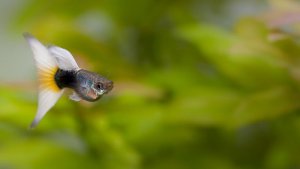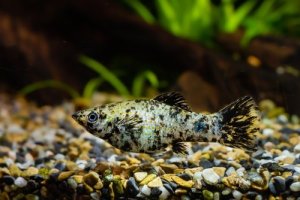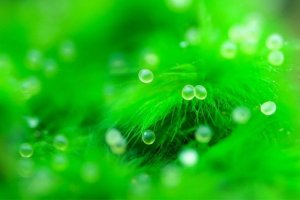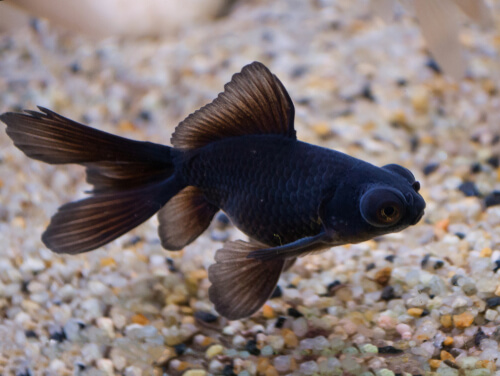
Breed Overview
| Origin | China |
| Lifespan | 10 years |
| Size | 5-8” or 13-20 cm |
| Colour | Dark velvety black with bronze or gold patches |
| Food | Omnivorous, but requires less protein than more active goldfish |
| Tank Size | Minimum 20-30 gallons/76-114 liters |
| Temperament | Shy, peaceful, at ease |
| Water Type | Freshwater |
| Water Temperature | 65-72 degrees F/18-22 degrees C |
| Water pH | 7-8 |
| Difficulty Level | Beginner – intermediate, but often sold to beginners. |
Species Summary
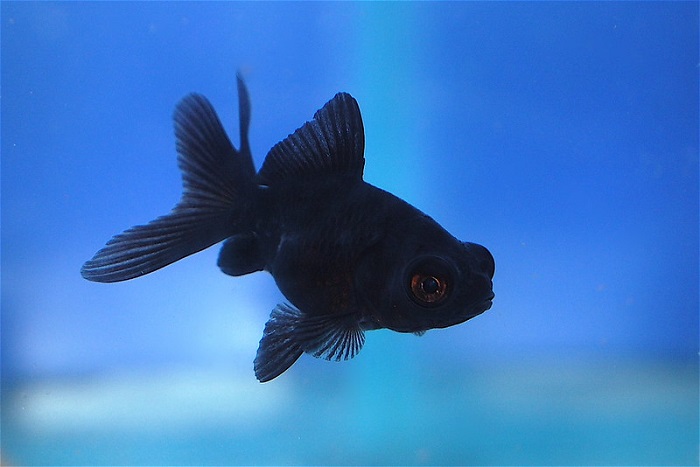
The black moor is a fancy goldfish with an unusual appearance; a deep, velvety black with undertones of bronze, especially when younger. The distinctive appearance of this fish is caused by the pigment melanin, and makes it a popular companion for many beginner aquarists. Indeed, it can often be one of the first goldfish you ever look after, but that does not mean this beautiful fish is necessarily simple to take care of.
The black moor is a sensitive fish with its own personality. Curious and enigmatic, this guide will show you how to take care of one of the most popular aquarium fish, ensuring a long lifespan and a happy fish.
Best Black Moor Goldfish Care: Creating The Right Habitat
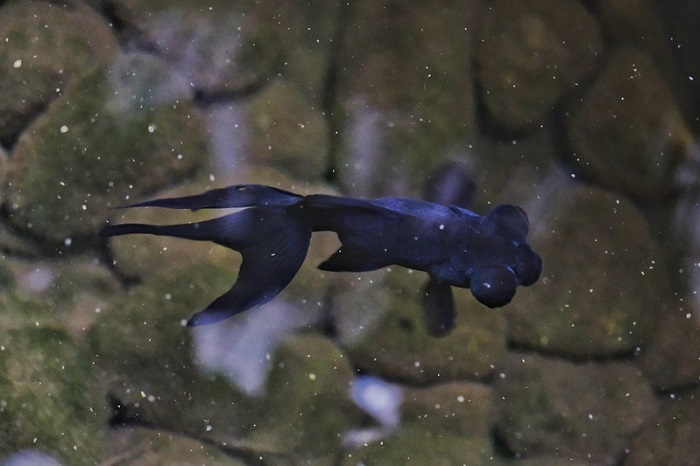
Tank Parameters
- Size: 30 gallons/114 liters minimum, and add an extra 10 gallons (38 liters) for each additional fish. Black moor goldfish like to be in groups of three or more.
- Substrate: Sand or gravel
- Filtration: The rule of thumb is a filter with a flow rate 4x tank size. Bear in mind heavily planted tanks need less filtration, and as weak swimmers, black moor goldfish can get sucked against the filter. In a heavily planted 30 gallon (114 liter) tank, you therefore could get away with a 150 gPh flow rate filter.
- Ammonia and Nitrates: zero
- pH level: 7-8
- Water Hardness: 5-19 dGh
- Temperature: 15-23 C 60-75 F
- Lighting: 8-9 hours of light per day. However, ensure this isn’t direct. Unlike some goldfish which can tolerate LED, the black moor has sensitive eyes, so ensure this isn’t direct. You could use an external light source.
- Tank Maintenance: it’s really important to keep the water crystal clear and clean. Not only does this prevent the beautiful scales of your fish from getting infected, cloudy water makes it harder to see, and these fish already have poor eyesight. Change the water once a week, although a larger change of 50% of the tank every month can help keep things in tip-top position.
Aquatic Plants And Tankmates
Plants For Your Black Moor Goldfish:
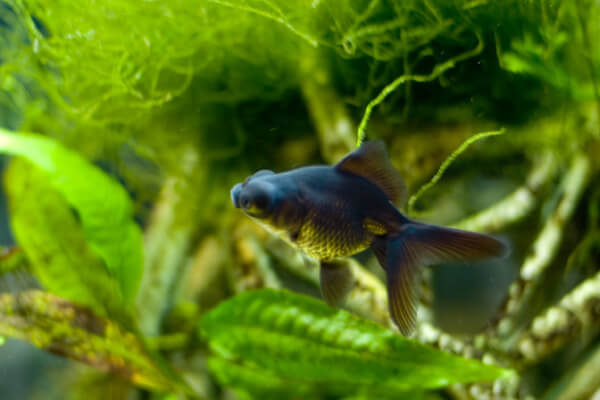
Like other fancy goldfish such as the oranda and bubble-eye, the black moor has features that mean it is a little bit more delicate. However, don’t let this deter you. A planted tank environment with places for your black moor to hide and swim also ensures these more sensitive fish feel safe.
Goldfish do have a habit of eating aquatic plants but if you include enough and let them establish, they should be fine. Good ones include:
- Sagittaria
- Hornwort
- Java moss
- Java fern
- Marimo moss balls
- Water wisteria
- Duckweed
- Anacharis
Best Vertebrate And Invertebrate Tankmates For Your Black Moor
The best tank mates for the black moor goldfish are other goldfish with impaired vision. This includes the panda black moor goldfish, telescopic goldfish, and bubble eye goldfish. Avoid hardy goldfish or fast-swimming fish as they out-compete your black moors. What this fish loves most is actually another group of their own kind, with at least three. However, aside from other black moors, the best tankmates for these goldfish include bottom-dwelling fish and invertebrates.
Some tankmates include:
- Ramshorn snails
- Apple snails
- Dojo Loaches
- Cherry Shrimp
- Ghost Shrimp
Choosing A Fish: The Panda Black Moor Goldfish And More
When wandering through your local aquatic store you may see a variety of telescopic-eyed goldfish in all manner of colors. One similar fish is the panda black moor goldfish, but, instead of being all black, its body is a paler color and there are rings of black around its eyes.
If you want a true black moor look for a goldfish that is almost entirely black. However, there is not a huge amount of care difference between the black moor and the panda black moor goldfish.
With a traditional black moor, you can identify good breeding through its dark matte black color and these tend to fetch the highest price. Black moor goldfish may also show striking areas of bronze and gold which were left over from when they were juveniles and this can increase again with age.
A black moor will cost from 8-15 USD, but those at the higher end of the spectrum will be better quality.
Feeding
Some goldfish like live food such as daphnia or brine shrimps, but having to catch free swimming live food can be challenging for the black moor with its poor eyesight. Instead, invest in some really good pellet food that is balanced and ensures that your black moor goldfish gets a full spectrum of nutrients.
One other issue with the live food is if your goldfish cannot eat it quickly enough it can be very hard to remove from the tank, raising the risk of parasitical bacterial infections. Many things affect how long a goldfish can go without eating, such as how healthy the fish are in the first place. However, in instances when you are away, it’s best to use slow release pellet food, to be safe.
So, What Can You Feed Your Black Moor Goldfish?
You can still create an enriched feeding environment for these cute little fish by adding vegetable matter such as lettuce, half or quarters of shelled peas, or broccoli. You can also still feed protein in frozen form. Yet, whether vegetables or protein, you should still remove uneaten food after 5 minutes.
Additionally many species of goldfish love to munch on the plants. A planted tank not only looks stunning but can also be a source of food itself. Black moors are not so prone to uprooting plants as some other goldfish breeds, so this is an easy setup to manage.
Temperament And Behavior Of Black Moor Goldfish:
The black moor goldfish is a shy fish that loves nothing more than hanging out in the middle of the water column with a group of other fish. You may often catch some hiding amongst the foliage in their habitat. These are not competitive fish at all ,which is why it’s best to keep them with similar fancy goldfish.
Black moors can sometimes nip each other’s fins. However when you ensure all their needs are met, they are less likely to exhibit this kind of behavior.
My Black Moor Goldfish Is Inactive: Is This Normal?
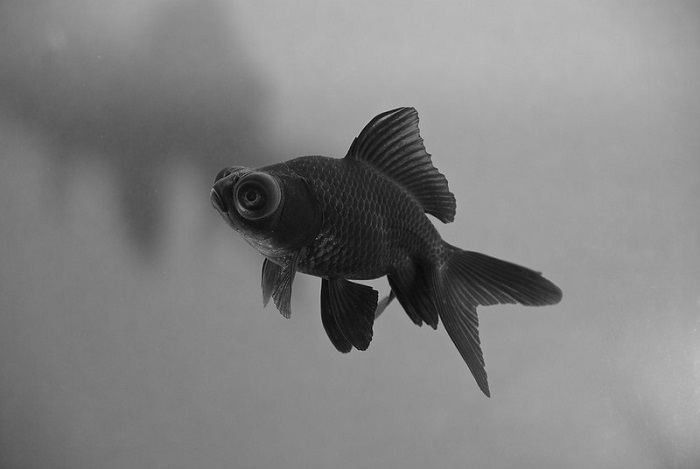
After watching your goldfish for a while you may notice that it is just hanging around midwater. These goldfish are not that active, and just enjoy hanging out in places where they feel safe.
Alternatively, it might be that your goldfish is asleep. It can be hard to tell, but black moor goldfish are normally active during the day. A more serious sign is if your fish seems lethargic as opposed to quiet, or starts not eating the food you provide.
Diseases:
Eye Infections
Eye infections are one of the most important diseases to watch out for when keeping black moor goldfish. Now, you may wonder how this fish’s telescopic eyes managed to develop if it can make the fish so prone to infection. The black moor is descended from the telescopic goldfish which gained the name of ‘dragon eye’ goldfish in China where it developed. As it was bred in captivity, it was not subject to the stresses of the natural world. Thus, the eyes of the black moor goldfish are not a hindrance.
Eye infections are caused by a number of factors such as poor water quality. One of the most common is cloudy-eye which is a sign of an internal bacterial infection. For all eye infections, you should improve the water quality ASAP. Move the fish to a separate tank and monitor both tanks until pollutant levels remain at zero. As there are many kinds of eye infection, if you are a beginner, it is best to see a specialist aquatic vet who can diagnose and prescribe treatment.
Why Is My Black Moor Goldfish Changing Color?
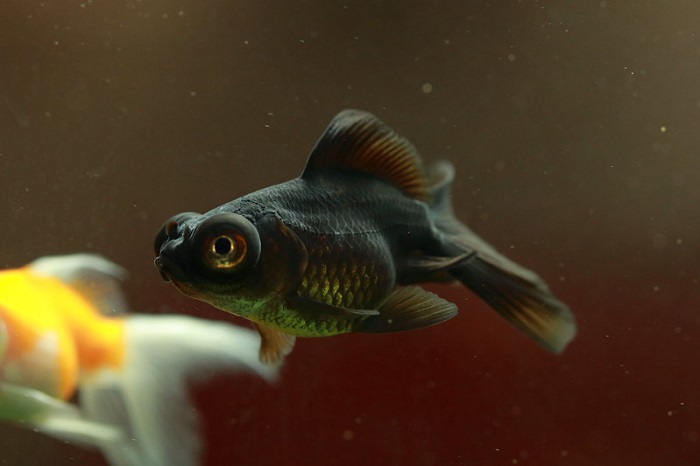
After purchasing a delightful looking velvety black goldfish it can be alarming to see the color change suddenly. However, this can just be due to the fish’s natural aging process.
Remember that when the black moor goldfish is young it is a golden bronze color and this can appear again as the fish grows old. If your fish still looks healthy and happy, it’s most likely old age. However, sometimes color changes can indicate a more serious disease or stress.
White: this can be a sign of stress. A poorly kept tank with bad filtration and dirty water can cause your black moor goldfish to grow paler. In fact, A white color is not natural for black moor goldfish, so if your goldfish is turning white it’s good to investigate to remove the sources of stress.
Temperature can also affect the color of your goldfish. A temperature that is too low (below 54 F/12 C) or too high (above 74 F/23 C or so) will stress them out and lead to pigmentation loss.
Velvet Disease
Whilst this affects tropical fish more frequently, it’s an important disease to recognize in black moor goldfish as it can appear to be natural color change at first. Unlike natural color change, if your black moor goldfish is infected by this nasty parasite you will notice unusual behavior. Ensure to take note if your fish:
- Swims near the surface
- Appears aimless, listless, or lethargic
- Bumps or rubs against the sides of the tank in an attempt to remove the parasite
- Seems to have difficulty moving water through its gills (more rapid or strained)
It is best treated with cooper chemicals, or by aquarium salt if you have other sensitive invertebrates in the tank. As this fish is a common beginner species, if you’re new to this, you may also want to consult a vet.
Breeding Black Moor Goldfish
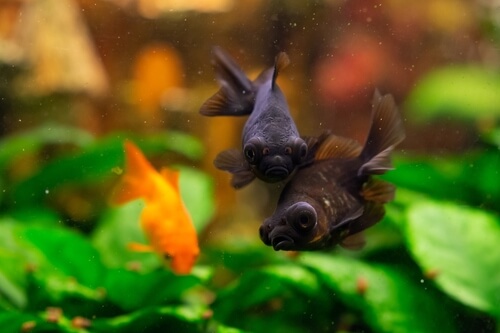
Like other breeds with impaired vision, the black moor goldfish needs careful breeding conditions, so ensure that you also have everything set up properly first. The breeding period is a time of vulnerability when they use extra energy. The black moor goldfish is very exciting to breed as the fry are not the velvet black color of the adults, but are instead deep bronze and you can watch them turn black as they grow.
If you are a newcomer to breeding or aren’t familiar with how goldfish mate, the black moor is probably not the best species to start with. However, if you are an experienced breeder, the black moor goldfish has a similar breeding pattern to all varieties of fancy and hardy goldfish. Just keep in mind the following things:
- You need to lower and then raise the water temperature to trigger breeding. This mimics the beginning of spring when goldfish breed naturally. It’s best to use a tank thermometer for these sensitive fish.
- Tank changes every day or every second day can ensure the fish are in the best condition to breed
- Males develop white growths on their gills, called tubercles
- Some species need a breeding mop for the eggs to attach to, but not the black moor. Instead, these fish disperse their eggs over the bottom of the tank
- Always remove parent fish after breeding, or they eat the eggs!
- Don’t miss out watching the courtship of these fish! Black moors dance elegantly in the water as the male chases the female, creating beautiful patterns with their fins.
Final Thoughts:
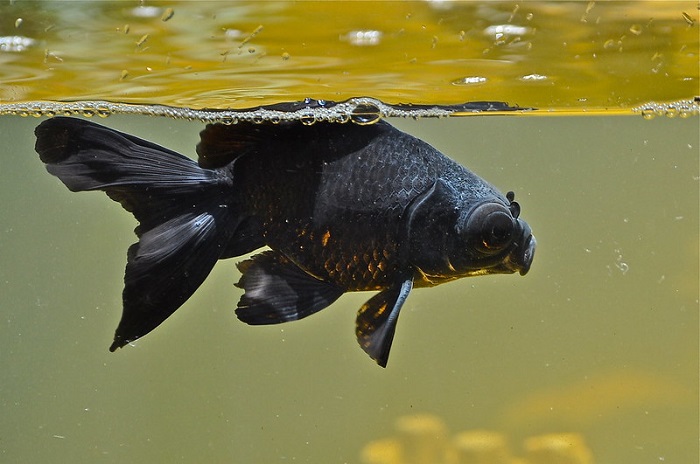
Ultimately, the black moor goldfish is a really special kind of fish as it’s unusual and exciting yet, as fancy goldfish go, relatively easy to take for. As many people buy this stunning fish as one of their first fancy goldfish, it’s not always obvious how to take care of them properly. However, this initially shy breed will reveal more and more of its personality the better you look after it, and a well-cared-for black moor is a lovable and mesmerizing companion for all ages.


